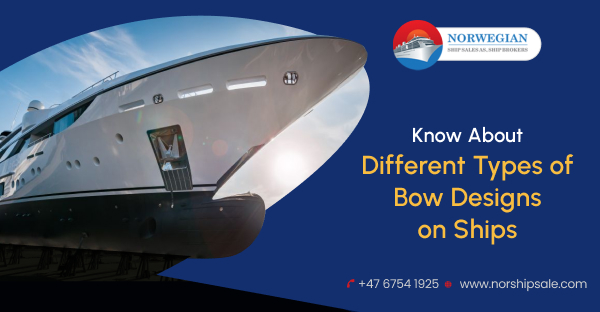It is the bow of a ship that makes it look beautiful, and attracts our attention with the very first look. So, it goes without saying that the bow adds to the aesthetic value of the vessel besides serving other important functions. Ships travel in water and endures a considerable amount of drag in comparison to airplanes face in air. Thus, the ship’s design must be so that its components’ resistance is minimised. This can be modulated by how waves and water interact with the vessel’s entry at the front end. The front end is where the ship and the water contact for the first time and the ship’s bow are located here. Over the years, ships’ designs have evolved to make them more efficient, and simultaneously the designs of the ship’s bow have also changed.
So, should you be someone who is planning to buy ships, then make it a point to stay updated about the different types of bow designs of ships. In this blog, we have discussed the same. Now, if you live in Norway, and want ships for sale in Norway, make sure to contact top ship brokers.

Normal Bow
The normal bow’ predecessor was vertical bow from which it was developed. Now, the angle where the ship’s stem meets the water is referred to as the rake. Unraked or vertical bow that has the straight edge is called the plumb bow. Such type of bows has a great waterline like an Inverted Bow or X-Bow, and a good waterline length allows the ship to attain a great hull speed.
The Bulbous Bow
The bulbous bow is the most common type of ship bow that is used in ship designs in the present day. This type of bows helps in reducing slamming on the ship and has a similar effect as that of the normal bows during ballasted conditions when the bulb section with sharp tapering issued. Plus, fuller form ships that voyage out in the rough ocean are resistant to wave breaks, while this is a useful element, on the other hand, this also eats away the propulsive efficiency. These effects can be reduced considerably using a Bulbous Bow with a water plane that is downward tapering.
So, should you be someone who is planning to invest in a ship for sale in Norway with a bulbous bow or any other bow shape and type, you must consult a good ship broker first.
Cylindrical and Parabolic Bows
Cylindrical Bows are generally designed for ships that have fuller-forms and are best when used in fully loaded conditions. When designed properly paying attention to the stem edge and bluntness, the Cylindrical Bows are expected to have minimum wave-making resistance.
Parabolic Bows also have a blunt stem shape and are given a rounded form similar to a bilged hull that is round in shape. This is to ensure a proper flow around the hull. For taking the wave-breaking resistance these bows are combined with Bulbs.
Axe Bow
A ship with an Axe Bow has a stem line of vertical shape along with an axe-shaped hull with deep, narrow and long front portions. Axe Bows allow the ship to navigate through the water and waves seamlessly.
X-Bow- Inverted Bows
In the case of a ship with X- Bows a majority of hull’s part is designed upside down. Thus, it is also called an Inverted Bow. Such hulls can allow maximum waterline length and ships can attain the highest hull speeds that are possible. Also, with this bow shape, fuel consumption can be reduced significantly.
Conclusion
This is what you need to know about the different types of bows on a ship, so hopefully, you have got a clear idea about the same, and how they help in sailing and other ways. When you stay updated and have proper knowledge, buying a ship for sale in Norway will become easier as you can ask the right set of questions to your shipbroker and seller, and understand what are your requirements, and which ship will meet them. However, to purchase the right ship at the right price, you must get in touch with an experienced shipbroker.

